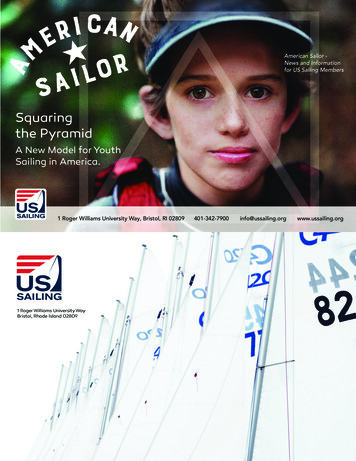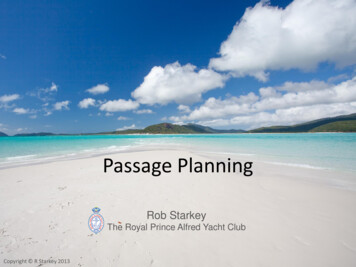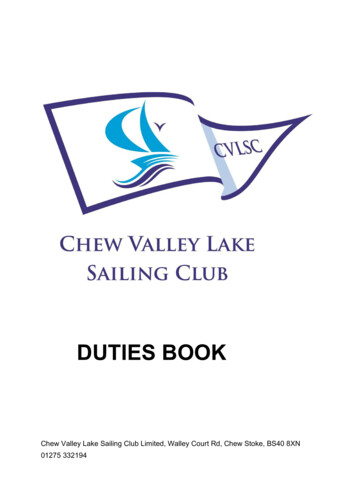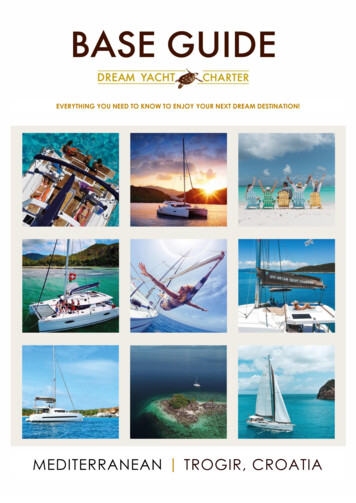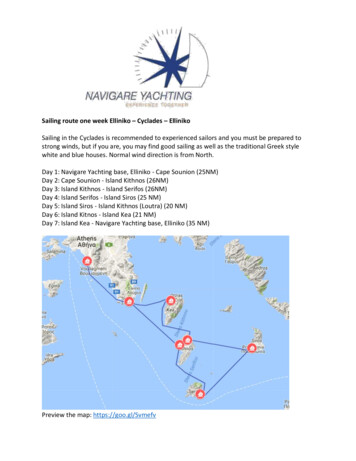![Teach Sailing The Fun Way Activity Guide Draft[1]](/img/28/teach-sailing-the-fun-way-activity-guide-draft1.jpg)
Transcription
TEACH SAILINGTHEFUN WAY!akaBeyond Wind and Sailing JeopardyA guide full of games, activities, and initiatives that facilitatelearningContributions from:2009 National Sailing Programs Symposium ParticipantsLong Island Sound Junior Sailing InstructorsCompiled by:Amy Kellogg, Former Chairman, Long Island Sound Junior Sailing AssociationRobert T .Crafa, Director of Waterfront ProgramsSUNY Maritime College6 Pennyfield Avenue, McMurray HallThroggs Neck, NY 10465Phone: 718-409-7460 Fax: 718-409-6112E-mail: rcrafa@sunymaritime.edu
Teach Sailing the Fun Way!Table of ContentsWELCOME. 4SUGGESTIONS FOR SUCCESSFUL ACTIVITIES . 5LESSON PLAN TEMPLATE . 6ACTIVITIES . 7Alphabet Lingo .8Boat Maintenance.9Burgee, Make Your Own.10Bubble Trail .11Build a Boat .12Burgee, Design Your Own .13Captain’s Coming.14Capture the Flag.15Chalk Boat Relay .17Chart Making Sailing Science .18Catch the Dragon’s Tail.20Chase the Coconut.21Clay Boat Building.22Collage.23Commercial.24Crewlywed Game, The.25Dance Contest .26Dead Reckoning Navigation.27Design Your Own Yacht Club.28Egg Drop, The.29Famous Name Game .30Fender Flinger.31Fetch!.32Fish Print Tee Shirts.33Fishing .34Flotsam & Jetsam Boats .35Greased Pig Race .36Harry Houdini .37Hit Man, Hit Woman.38Human Knot.39I Spy .40Internet Resources.41Jeopardy, Sailing.43Jump the Brook .44Jump the River .45Kayaking.46Knights, Cavaliers, and Horses.47Knots .48Land Skills Relay Race .50Logbooks .51
Mad Libs.52MAFIA .54Main Sheet Joust .55Mainsail Puzzle .56Mechanics of an Optimist.57Memory .58Nomenclature.59Physical Fitness.60PIE.61Raccoon Circles .62Rain Gutter Regatta.63Rigging Races .64Rock Around the River.65Rope Rugs.66Sailing Invite.67Sailmakers Patch, Design Your Own.68Ship Shape .69Signal Flag Project .75Skill Race.77Snipe Hunt .78Spider and the Flies.79Stick, Stick, Capsize.80Styrofoam Prints .81Team Shirts.82Theme Days .83Threshold .85Tie Dye T-Shirt and Signature.87Truth or Lie.88What’s Wrong? (with this picture).89Vermonster .90ADDITIONAL ACTIVITIES IN NEED OF LESSON PLANS. 97ACTIVITIES CROSS REFERENCED . 91RESOURCES . 95Bag of Tricks .95Books.95Prizes .95Web Sites.96
WelcomeTeaching Sailing the Fun Way! is a compendium of fun and creative teaching techniques that areused by sailing instructors around the country. Many of the activities were contributed byindividuals like you.Over the years each of our programs has developed a collection of games and activities to teachsailing concepts and engage young sailors. From field trips to scavenger hunts, to pirate days toOlympic events, there are an endless assortment of games, crafts, trips and activities that arealready a part of many programs. In order to share in the talents and creative energies of ourinstructors, committees and family members, we are collecting the best of the best.We ask everyone to continue submit their favorite activities or add to detail or extensions tothese existing activities. Be generous, the more we share, the more valuable the resource willbe. With your help, this guide will grow from year to year and will continue to be a resource forour programs.Please share with us your favorite: Ice Breakers Trust Initiatives Team Building Activities Land Games and Activities for when the weather won’t cooperate Water Games and Activities Activities that teach sailing, water safety or other concepts in a fun, creative way Science enrichment lesson plans that correlate sailing with science, math, Englishand environmental educationPlease use the lesson plan template provided to organize and share your activities. Feel free tomake additional copies or e-mail Rob Crafa - rcrafa@sunymaritime.edu for an electronic copy tosubmit additional ideas.Remember, life is what you add to it.Thank you for your time and generous contributions.Amy and Rob
Suggestions for Successful Activities1) Be a role model for junior program participantsi) Present a positive attitude – be enthusiastic about new games and activities – these arefun, educational activities – NOT time killersii) Don’t speak bad about participants, instructors, boats/equipment or the activities.iii) Always wear closed toed shoes and your life jacket on or near the water2) Mix up competitive and noncompetive games so it is not always about winning sometimes itshould just be about fun.3) When choosing teams do so randomly, no one likes to be the last one picked. Ways toaccomplish this:i) Count participants off randomly 1-2-1-2ii) Have participants arrange themselves in order by height, birthday (month and day) orother means and divide the group evenly down the middle.4) Remember: Safety, Fun, Learning - must occur in this order5) Provide feedbacki) Do you have an activity that works well for you that is not in here? Let us know wewill include it!ii) Can you improve an activity in here by offering additional teaching procedures,materials that would be helpful, safety warnings, extensions to adapt the activity inanother fun way or techniques to help debrief the activity?6) Use at your own risk!
Lesson Plan TemplateActivity Title:Goal, Objective or Purpose of Activity:Appropriate Age Level: Any; 3-5; 6-8; 8-10; 10-14; 14-18, Adult,Minimum/Maximum Number of Participants:Set-up Time Required:0-15 minutes15-30 minutes30 minutes – 1 hour1 hour Activity Time Required:0-15 minutes15-30 minutes30 minutes – 1 hour1 hour Space Requirements: Beach; Field, Parking Lot, Classroom (indoors only), On-the-water; Normal MeetingAreaMaterials/Resources:Procedure for Teaching: Step-by-step plan that others could follow (feel free to continue on reverse side)Student Product: Journal entry, worksheet, artifact (if any).Extensions: Related resources, other similar activities
Activities
Alphabet LingoGoal, Objective or Purpose of Activity:Review terminologyAppropriate Age Level:AnyMinimum/Maximum Number of Participants:2 Set-up Time Required:0-15 minutesTime Required for Activity:15-30 minutesSpace Requirements:Normal meeting areaMaterials/Resources:NoneProcedure for Teaching:Everyone tries to name a nautical tem beginning with a letter of the alphabet. You can eitherhave each player name something with the same letter, before moving to the next letter (A,A, A,A, B, B, B, C, C, C ) or rotate on letter with each player until a player is stumped (A, B, C,D .)Example: A Aft, B Ballast, C CunninghamVariation: Start with any letter, the next person has to name something that starts with the lastletter of the pervious term Example: Anchor – Reef Hook – Keel - LaylineStudent Product:Extensions:Can be played with any category from cities, to countries, types of fish, first names, etc.
Boat MaintenanceGoal, Objective or Purpose of Activity:Teach participants to understand and appreciate necessary maintenance on sail or power boat.Appropriate Age Level:8 Minimum/Maximum Number of Participants:2 Set-up Time Required:30 minutes – 1 hourActivity Time Required:30 minutes – 1 ½ hourSpace Requirements:classroom, workshop or dockMaterials/Resources:Depends on maintenance projectIdeas?1) Hull cleaning and waxinga) Running waterb) Boat Zoap, Simple Green or other cleanerc) Bucket(s)d) Sponge(s)e) Boat wax with applicator padf) Clean towels/rags to remove waxSail Repair?Gel coat repair?Engine Maintenance – oil change, lower gear unit oil, spark plugs, fuel/water separator, batteryProcedure for Teaching: Depends on maintenance project chosenStudent Product:Extensions: See owners manual or manufacturers web site for recommended maintenance Start Powerboating Right, United States Sailing AssociationReflection:Contributor(s):Merry Petitclair
Burgee, Make Your OwnGoal, Objective or Purpose of Activity:Team building, build team/club spiritAppropriate Age Level:8 – 16 years oldNumber of Participants:3 Set-up Time Required:15-30 minutesActivity Time Required:15–30 minutesSpace Requirements:Classroom or normal meeting areaMaterials/Resources:1) Pre-cut triangle (burgee shaped) cut outs on paper, old t-shirts, old sail material or towels2) Colored MarkersProcedure for Teaching:Ask sailors to create their own burgee for their boat, their class, for a team or for the juniorprogram. This can be a contest.Student Product: ine Singer, Head of the Bay Club; Emlie Barkow
Bubble TrailGoal, Objective or Purpose of Activity:To learn wind directionAppropriate Age Level:6-8; 8-10Minimum/Maximum Number of Participants:Set-up Time Required:0-15 minutesActivity Time Required:15-30 minutesSpace Requirements:On-the-waterAllMaterials/Resources: A bottle of bubbles with wand for each boat Tape to secure bubble (prefer non-marking tape such as blue painters tape)Procedure for Teaching:1.Tape a bottle of bubbles to the side of each boat.2.Have kids dip wands into bubbles while on the water to see which way the wind is blowing.Student Product:Extensions:
Build a BoatGoal, Objective or Purpose of Activity:Reward participants for following direction/focusing on lessonAppropriate Age Level:8 Minimum/Maximum Number of Participants:2 Set-up Time Required:0-15 minutesActivity Time Required:30 minutes-1 hourSpace s of Paint or Popsicle SticksProcedure for Teaching:1. Brief sailors on drills and inform them they will be rewarded for performing drill well,listening, etc. with paint sticks labeled with parts of boat2. Object is to gather all parts of boat3. First to do so gets prize (i.e. first to lunch, have others derig their boat)Student Product:Extensions:Reflection:Contributor(s):Amy Zang
Burgee, Design Your OwnGoal, Objective or Purpose of Activity:Learn the history of the burgeeCreate your own identity or group burgeeBuild team spiritAppropriate Age Level: AnyMinimum and Maximum Number of Participants: AnySet-up Time Required:15-30 minutesActivity Time Required:15-30 minutesSpace Requirements:Materials/Resources:Scrap pieces of spinnaker cloth from sailmakerFabric glue or needles and thread, scissorsProcedure for Teaching:Have kids design their own burgees using scrap spinnaker cloth. Research the history ofburgees. Fly burgees from the rigging of their boat.Student Product:Extensions:
Captain’s ComingGoal, Objective or Purpose of Activity:Terminology - Learn Parts of the BoatAppropriate Age Level:8 Number of Participants: 6 – 20Set-up Time Required:0-15 minutesActivity Time Required:15-30 minutesSpace Requirements:Open area (floor, sidewalk, parking lot, deck) to trace out boat shapeMaterials/Resources:1) Chalk to trace out boat shapeProcedure for Teaching:1) “Simon Says” with “Captain Says” plugged in.2) “Captain Say go to ” bow, stern, starboard, port, etc.3) Other fun movements plugged in (e.g. swab the decks with mopping motion)Student Product: N/AExtensions: N/AReflection:Contributor(s):C. Harman, Norwalk Yacht Club
Capture the FlagGoal, Objective or Purpose of Activity:Build teamwork, exercise, funAppropriate Age Level:8 Number of Participants: 10 Set-up Time Required:Activity Time Required:30 minutesSpace Requirements:Open field or area to run around in, on-the-water (with kayaks)Materials/Resources:1) Divider between the two sides, which can be as simple as a long line2) Flags for each side which can be a shirt, life jacket or shoesProcedure for Teaching:1) Each team has its own territory in which its team members are free to move as they please,but on which opponents enter at their peril. The territories are separated by a boundary linesuch as a brook or a trail, etc. Any participant crossing this line may be captured by theenemy.2) The teams assemble close together at a starting point near the center of the line, each team inits own territory. On a signal the teams proceed to set their flags at any point within 200 stepsof the starting point The flags must be visible, although it is permissible to place them asinconspicuously as possible.3) After three minutes another signal is given for start of game. The object now is to enter theenemy's territory, capture the flag, and carry it across the line into home territory withoutbeing caught. Participants may be posted to guard the flag, but not get nearer than 50 feet toit, unless an enemy goes within the 50-foot circle. They may then follow him.4) Any participant found in the enemy's territory may be captured by grasping him long enoughfor the captor to say "Caught!" three times. When a participant is captured he must go withcaptor to the "guard house" - a tree or rock from the boundary line.5) A prisoner may be released by a friend touching him, provided the prisoner at that time istouching the guard house with a hand or a foot, whereupon both return to their own territory.If the rescuer is caught by the guards before he touches the prisoner, he, too, must go to theguard house. A rescuer can rescue only one prisoner at a time.6) If the flag is successfully captured, it must be carried across the line into home territory. Ifthe raider is caught before he reaches home, the flag is set up again at the point where it wasrescued and the game as before. If neither side captures the enemy's flag within the timeagreed up on (say, 1/2 hour) the game is won by the team with the most prisoners.
7) Alternative Rulesa) Hidden Flag - Allow each team to hide their flag out of sight. Before starting the gameallow a scout from each team to be shown where the flag is. He must describe accurately,to his team, where the flag is. This requires that the scout be very observant.b) Get Out of Jail Free - All team members caught in the jail can be set free when a singleteammate touches the jail. BUT, they do not have free passage back to their territory.c) Jail Break - If the game begins to stall, allow the judges to yell "Jail Break." At thismoment all players in both jails are free to escape.d) Orienteering Skills 1 - Leaders hide flags and give 2 starting points for each team along abase line. Teams are split in two and sent to the starting points. At the starting point eachgroup is given a compass bearing to their OWN flag. Each group follows its bearing - ifthey do it correctly the flag will be near where the bearings cross. Once each team locatesits flag they will also find a map with bearings to the "enemy flag" which was left there.The game then proceeds as usual. (Contributed by Mike Mullen, Troop 6, BostonMinuteman Council).e) Orienteering Skills 2 - Give both teams maps with starting points marked and bearings,and let them work it out on the map rather than having to actually walk the bearings.(Contributed by Mike Mullen, Troop 6, Boston Minuteman Council).f) Kayaks – Instead of playing on land, same game can be played in kayaksStudent Product: N/AExtensions: See also US Scouting Service Project at http://usscouts.org/games/game cf.aspReflection:Contributor(s):Leigh Hammel, Riverside Yacht Club with additional information fromUS Scouting Service Project (http://usscouts.org/games/game cf.asp)
Chalk Boat RelayGoal, Objective or Purpose of Activity:Terminology - teach parts of the boatAppropriate Age Level:AnyMinimum/Maximum Number of Participants:4 Set-up Time Required:0-15 minutesActivity Time Required:15-30 minutesSpace Requirements:20’ X 20’ parking lot or sidewalkMaterials/Resources:Sidewalk chalkProcedure for Teaching:1. Divide the group into two or more teams2. Have teams line up around parking lot/sidewalk3. Give first person in each line a piece of sidewalk chalk4. Instructor call out boat part or provides each team list of boat parts5. Teams race to draw and label all the parts of the boatStudent Product:Extensions:Reflection:Contributor(s):
Chart Making Sailing ScienceGoal, Objective or Purpose of Activity:At the end of the activity participants will be: more comfortable in boats; better able to navigate;more familiar with body of water; able to name three types of bottom composition; and, sail acompass headingAppropriate Age Level:AnyMinimum/Maximum Number of Participants:1 – 200 Set-up Time Required:30 minutes – 1 hourActivity Time Required:1 hour (entire season or more)Space Requirements:classroom, normal sailing areaMaterials/Resources:1) Create a Lead Line/Sounding Line with: Line marked in feet or meters and weight for end ofline (i.e. mushroom or danforth anchor, bucket filled with cement)2) Poster board3) Pencils4) Notepads/Note paper (one for each boat)5) Compass (one for each boat)6) Parallel rules (optional)Procedure for Teaching:1) Participants are going chart the body of water they are sailing in by taking depth soundings,checking bottom composition, finding currents and normal water movement.2) Activity – Part I: Classroom Introduction:We are going to be cartographers and map our body of water. Use chart to explain concepts(i.e. soundings, landmarks, compass rose). We will improve our boat control, steer a compassheading and need the help of every individual on the boat. Instruct participants how to take acompass heading (how? Resource?)3) Activity – Part II: On-water SamplingThis can be done with paddles (canoe or hands) or with wind. Evenly space boats out andgive them a compass heading they are going to follow. Similar to a start of a race. By timeintervals, random by instructor or specific distance have the boats take a depth check withweighted line. Participants will keep track of information on note pads. You can get asspecific as the group allows. Spend an hour taking depths and then come together to createyour chart.4) Activity – Part III: Classroom PlottingAn instructor traces or draws the boundary of your body of water on a poster board. Scalecan be set (another lesson) or estimated. The whole group marks their routes in pencil byfreehand or parallel rules and compass headings (helps to trace compass rose). Participantsthen record depths, bottom composition, whatever was found. Displaying this chart on thewall and continue making improvements. With more people each team or small group canmake their own chart. Everyone loves to see their work on display. The possibilities areendless.
Student Product:1) One group chart or individual chart (in their log books)Extensions:1) Use charts to plan a scavenger hunt or trip2) Sailing a mark or specific compass heading3) Study history of cartographyReflection:1) How did it go? What could we have done to make the chart more accurate?2) What other attributes would it be useful to measure? How might we do that?Contributor(s):Peter Baumgartner, Seacamp (Big Pine Key, Florida)
Catch the Dragon’s TailGoal, Objective or Purpose of Activity:Teamwork, communication, funAppropriate Age Level:AnyMinimum/Maximum Number of Participants:10 Set-up Time Required:0-15 minutesActivity Time required:15-30 minutesSpace Requirements:Large open area clear of obstructions for “dragons” to runMaterials/Resources:“Tail” for each dragon can be spare t-shirt, protest flag, bandana,ragProcedure for Teaching:1) Split group in two (or more if more than 20? people in each dragon)2) Make two single file lines with first person in each line facing each other.3) Place tail in back pocket or hanging from last person in line4) Have participants grasp the hips of person in front of them – hang on!5) On Go! Dragon head tries to capture the “tail” of the other dragon before their tail is caught.6) If dragon breaks (participants let go of person in front of them) – Stop! Reattach.Student Product:Extensions:Found in New Games/More New GamesReflection:Contributor(s):Merry Petitclair
Chase the CoconutGoal, Objective or Purpose of Activity:Boat HandlingAppropriate Age Level:8-16Minimum/Maximum Number of Participants: 2-12Set-up Time Required:0 -15 minutesActivity Time required:1 hourSpace Requirements:Normal Sailing AreaMaterials/Resources:1) Coconuts (after strong winds) or tennis ballsProcedure for Teaching:1) Explain to sailors object is to retrieve as many coco’s (or tennis balls) as can be picked up inboat2) Boat with most Coco’s (or tennis balls) wins!Student Product:Extensions:1) See also Fetch!2) No wind Version – sculling, rowing or swimming to collect Coco’s or tennis balls (imagineswimmers with suits full of tennis balls)Reflection:Contributor(s):Daniel Starsong, Big Island Sailing Foundation (Kona, Hawaii)
Clay Boat BuildingGoal, Objective or Purpose of Activity:To create a “boat” from a piece of modeling clay that will carry as much “cargo” as possibleAppropriate Age Level:AnyMinimum and Maximum Number of Participants:Set-up Time Required:0-15 minutesTime Required for Activity:15-30 minutesAnySpace Requirement
individuals like you. Over the years each of our programs has developed a collection of games and activities to teach sailing concepts and engage young sailors. From field trips to scavenger hunts, to pirate days to Olympic events, there are an endless assortment of games, crafts, trips

